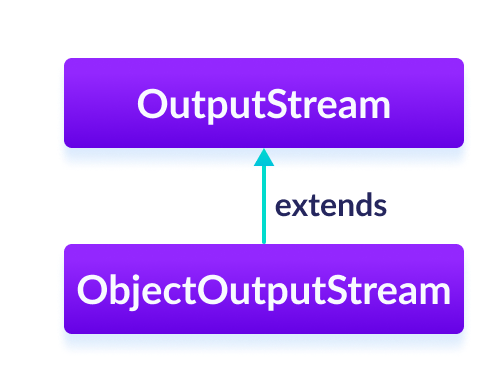The ObjectOutputStream class of the java.io package can be used to write objects that can be read by ObjectInputStream.
It extends the OutputStream abstract class.

Working of ObjectOutputStream
Basically, the ObjectOutputStream encodes Java objects using the class name and object values. And, hence generates corresponding streams. This process is known as serialization.
Those converted streams can be stored in files and can be transferred among networks.
Note: The ObjectOutputStream class only writes those objects that implement the Serializable interface. This is because objects need to be serialized while writing to the stream
Create an ObjectOutputStream
In order to create an object output stream, we must import the java.io.ObjectOutputStream package first. Once we import the package, here is how we can create an output stream.
// Creates a FileOutputStream where objects from ObjectOutputStream are written
FileOutputStream fileStream = new FileOutputStream(String file);
// Creates the ObjectOutputStream
ObjectOutputStream objStream = new ObjectOutputStream(fileStream);
In the above example, we have created an object output stream named objStream that is linked with the file output stream named fileStream.
Methods of ObjectOutputStream
The ObjectOutputStream class provides implementations for different methods present in the OutputStream class.
write() Method
write()- writes a byte of data to the output streamwriteBoolean()- writes data in boolean formwriteChar()- writes data in character formwriteInt()- writes data in integer formwriteObject()- writes object to the output stream
Example 1: Java ObjectOutputStream
Let's see how we can use ObjectOutputStream to store objects in a file and ObjectInputStream to read those objects from the files
import java.io.FileInputStream;
import java.io.FileOutputStream;
import java.io.ObjectInputStream;
import java.io.ObjectOutputStream;
class Main {
public static void main(String[] args) {
int data1 = 5;
String data2 = "This is programiz";
try {
FileOutputStream file = new FileOutputStream("file.txt");
// Creates an ObjectOutputStream
ObjectOutputStream output = new ObjectOutputStream(file);
// writes objects to output stream
output.writeInt(data1);
output.writeObject(data2);
// Reads data using the ObjectInputStream
FileInputStream fileStream = new FileInputStream("file.txt");
ObjectInputStream objStream = new ObjectInputStream(fileStream);
System.out.println("Integer data :" + objStream.readInt());
System.out.println("String data: " + objStream.readObject());
output.close();
objStream.close();
}
catch (Exception e) {
e.getStackTrace();
}
}
}
Output
Integer data: 5 String data: This is programiz
In the above example, we have used the readInt() method and readObject() method to read an integer data and object data from the files.
Here, we have used the ObjectOutputStream to write data to the file. We then read the data from the file using the ObjectInputStream.
Example 2: Java ObjectOutputStream
Let's take another example,
import java.io.FileInputStream;
import java.io.FileOutputStream;
import java.io.ObjectInputStream;
import java.io.ObjectOutputStream;
import java.io.Serializable;
class Dog implements Serializable {
String name;
String breed;
public Dog(String name, String breed) {
this.name = name;
this.breed = breed;
}
}
class Main {
public static void main(String[] args) {
// Creates an object of Dog class
Dog dog1 = new Dog("Tyson", "Labrador");
try {
FileOutputStream fileOut = new FileOutputStream("file.txt");
// Creates an ObjectOutputStream
ObjectOutputStream objOut = new ObjectOutputStream(fileOut);
// Writes objects to the output stream
objOut.writeObject(dog1);
// Reads the object
FileInputStream fileIn = new FileInputStream("file.txt");
ObjectInputStream objIn = new ObjectInputStream(fileIn);
// Reads the objects
Dog newDog = (Dog) objIn.readObject();
System.out.println("Dog Name: " + newDog.name);
System.out.println("Dog Breed: " + newDog.breed);
objOut.close();
objIn.close();
}
catch (Exception e) {
e.getStackTrace();
}
}
}
Output
Dog Name: Tyson Dog Breed: Labrador
In the above example, we have created
ObjectOutputStreamnamed objOut using theFileOutputStreamnamed fileOutObjectInputStreamnamed objIn using theFileInputStreamnamed fileIn.- An object dog1 of the Dog class.
Here, we have then used the object output stream to write the object to the file. And, the object input stream to read the object from the file.
Note: The Dog class implements the Serializable interface. It is because the ObjectOutputStream only writes objects that can be serialized to the output stream.
Other Methods Of ObjectOutputStream
| Methods | Descriptions |
|---|---|
flush() |
clears all the data from the output stream |
drain() |
puts all the buffered data in the output stream |
close() |
closes the output stream |
To learn more, visit Java ObjectOutputStream (official Java documentation).
Also Read: